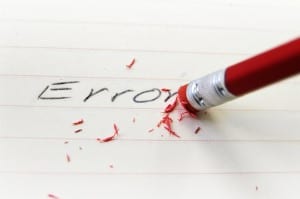
First, bear in mind that copy editing and proofreading are different tasks. Copy editing involves ensuring that your work complies with the particular style you’re supposed to be using (e.g., Associated Press, the Chicago Manual, American Psychological Association [APA], etc.), that the copy flows smoothly, etc. Proofreading consists of correcting errors in spelling, punctuation, grammar, word choice as well as formatting mistakes such as improper fonts, alignment, etc.
The trouble with checking your own work is that since you’ve been so involved with the text, you will very likely see what you expect to see rather than what’s actually there. If possible, ask a colleague to be a second pair of editing/proofing eyes.
Whether you’re tackling editing and proofing duties on your own or with support, the following techniques will help you stand a better chance of catching inconsistencies or errors.
1. Do not rely on your computer’s spellcheck and grammar functions. They won’t always catch homophone (words that sound the same but are spelled differently) errors. Also, they may suggest incorrect grammatical changes such as treating a range of years as a plural subject. Mine does this often and stating that 2010-2011 “were a time of economic challenges” is just not advisable.
2. If you’re proofing and editing for someone else, scan the entire document first. Having a general idea of the material makes the process go more smoothly.
3. Devote different rounds to different editing tasks. E.g., check for grammar on one round, look for consistency of terms during another, then formatting, etc. You may want to use different colors to make each type of editing correction in order to avoid confusion.
4. If the document is in a computer file, print out a hard copy. You’re more likely to spot errors when your eyes don’t have to cope with screen glare.
5. Read the copy aloud so that you can listen to the flow. Watch out for a monotonous rhythm, wordiness, and poor transitions.
6. Try to do heavy editing when you feel most energetic and alert. You’ll catch more errors.
7. Overinvolvement in the copy can blind you to flaws. Walk away from it for a few days or at least a few hours to get a fresh perspective.
8. Some writers swear by reading text backwards. It slows them down and helps them focus on the words themselves rather than the meaning of the text.
9. Keep your dictionary, grammar guide, and stylebook close at hand during the editing stage. There is no shame at all in checking a rule or word even if you think you should know it.
Sooner or later, an error will slip by you despite your best efforts. Mistakes happen; you just want to make sure they are a rare occurrence. If you feel you need additional help, check out the grammar and composition editing checklist at About.com and Purdue Online Writing Lab’s proofreading guidelines.

